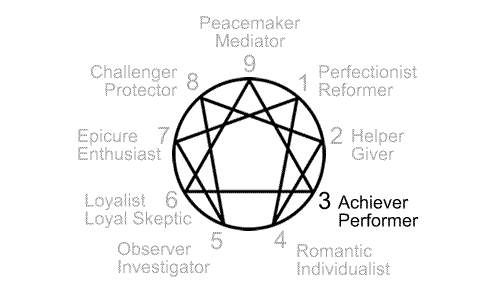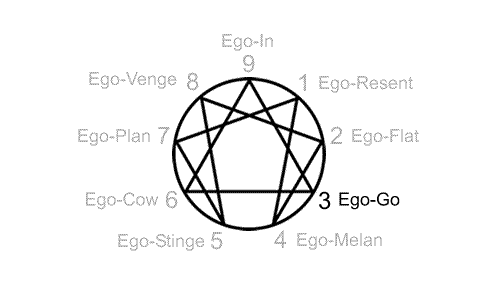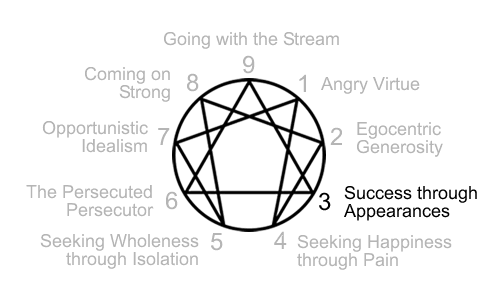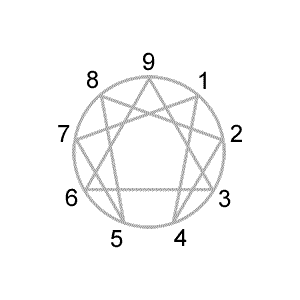Enneagram Type 3: Esteem through Emotional Ambition
The core focus of Enneagram type 3

The measure of who we are is what we do with what we have.
- Vince Lombardi
Early in life we develop an initial belief about ourselves and a compensation for that self-belief.
-
Type 3 Initial Self-Belief: “I am not valued as I am.”
Type 3 Compensation: "I must become accomplished and prove myself to gain value and regard in the eyes of others."
Over time this gets generalized beyond the self into a core focus that also shapes how we perceive and interact with the world at large.
-
Type 3 Core Focus: Esteem comes from being valued and having the positive regard of others. This requires that I not only package myself and perform in ways that will garner that recognition and positive regard but also find ways of measuring my success toward those ends.
Personality characteristics that might arise from the type 3 core focus include:
- Looks to external indicators for how well they're performing.
- Packages and markets self-image that's admired by intended audience.
- Pushes aside feelings that get in the way of achieving goals.
- Sense of self-value comes from what they produce or accomplish.
- Competes in arenas where there is someone to beat and someone to notice.
- Chamelon-like shifts of image occur to match situational expectations.
- Confuses self-presentation with who they truly are.
- Avoids failure by avoiding pursuits where failure is a possibility.
- Gives priority to goals and achieving them over other things.
Enneagram author descriptions of type 3

Below are Enneagram type 3 description samplings from some popular or well-known Enneagram authors. Click on the sources after the descriptions to further explore these interpretations.
-
The Achiever, The Success-Oriented, Pragmatic Type: Adaptable, Excelling, Driven, and Image-Conscious1
Basic Fear: Of being worthless, without value apart from their acheivements1
Basic Desire: To feel worthwhile, accepted, and desirable1
-
How Threes Pay Attention: To an observer, a Three looks like a highly focused achiever; Threes report, however, that they are only trying to keep up. If someone else is good, the Three has to be better, because a Three’s self-esteem is riding on a win.2
Basic Proposition: You gain love, recognition and acceptance through performance, doing and success.2
Strengths: Enthusiastic, action-oriented, problem-solving, successful, efficient, practical and competent2
Challenges: Image-driven, over-worked, impatient, competitive, out of touch with feelings2
-
Energy goes into: Getting things done quickly and efficiently. Staying active and busy. Competing. Achieving recognition and credit for accomplishments. Adjusting to whatever is required for success. Promoting myself. Looking good.3
-
The Performer: Success-oriented, image conscious and wired for productivity, they are motivated by a need to be (or appear to be) successful and to avoid failure.4
-
Achievers are energetic, optimistic, self-assured, and goal-oriented.5
-
Focus of Attention: Threes focus attention on tasks and goals to create an image of success in the eyes of others. Threes identify with their work, believing they are what they do, and lose touch with who they really are.6
Sources
1Book: The Wisdom of the Enneagram; Website: The Enneagram Institute
2Book: The Enneagram; Website: The Narrative Enneagram
3Book: The Essential Enneagram; Website: Dr. David Daniels
4Book: The Road Back to You
5Book: The Enneagram Made Easy
6Book: The Complete Enneagram; Website: Chestnut Paes Enneagram Academy
Type 3 Ego: Ego-Go

The roots of the Enneagram types come from Oscar Ichazo's ego types. The ego types identified how a person was fixated in ego and the remedy for finding freedom from that.
Below are descriptions of Oscar Ichazo's ego type 3 fixation, trap, holy idea, passion, and virtue reinterpreted for today's Enneagram personality types.
Type 3 Fixation and Trap
Fixation: Vanity comes from gaining a sense of value through accomplishments and subsequent recognition.
Trap: Efficiency comes from pursuing the most effective path forward toward achieving your set goal.
The fixation of vanity points to the mental preoccupation of the type 3 ego. The trap of efficiency keeps an individual stuck in the fixation.
Type 3 Holy Idea
Holy Idea: Holy Hope is finding intrinsic value in just being rather than needing affirmation and validation through your accomplishments.
The fixation of vanity and trap of efficiency keep an individual stuck in the type 3 fixation. The way out of that fixation is through holy hope.
Type 3 Passion
Passion: Deceit involves taking on a persona that appeals to an intended audience. "I have difficulty knowing who I am separate from the image I'm presenting."
The passion of deceit is the emotional energy that serves the fixation of vanity and trap of efficiency.
Type 3 Virtue
Virtue: Truthfulness appears when you find a sense of self that is true to who you are instead of playing to the expectations of an intended audience.
The virtue of truthfulness is what appears when the passion of deceit subsides.
Personality traits of Enneagram type 3

A psychiatrist named Claudio Naranjo evolved Oscar Ichazo's ego-types into the Enneagram personality types as we use them today. Naranjo largely based the types on Ichazo's passions.
Naranjo outlined the following trait structure for type 3 (Ennea-type III) in his books Ennea-type Structures and Character and Neurosis.
- Success through Appearances - Vanity, Inauthenticity, and the "Marketing Orientation"
- Attention Need and Vanity
- Achieving Orientation
- Social Sophistication and Skill
- Cultivation of Sexual Attractiveness
- Deceit and Image Manipulation
- Other-Directedness
- Pragmatism
- Active Vigilance
- Superficiality
Enneagram type 3 examples
While reading about the Enneagram types can be useful in understanding them, you eventually have to bring the types to life by seeing the many different ways they get expressed in life.
While the ideal is to be able to interact directly with people of each type, an alternative is to observe them from a distance. There are a number of ways to do this using videos. Many of these videos can be found on the Internet if you know what to look for (YouTube in particular).
- Type 3 Interviews and Self-Revelations
One method used to bring the types to life when teaching the Enneagram types involves interviewing people of a given type about how that type plays out in their life. This may be done through panels and one-on-one interviews.
Self-revelatory videos can also be useful where a person simply describes their type to a camera without the prompting of an interviewer.
Note that sometimes a person in a video may have been mistyped and may not offer an accurate representation of type when that happens.
- Type 3 Celebrities or Famous People
Once their Enneagram type is known, celebrities or famous people can also offer interesting examples of and insights into Enneagram type as revealed through interviews, lectures, writings, and the person's work.
However, it's not like the Enneagram panels, interviews, and self-revelations where people are specifically describing how they experience Enneagram type in their lives. It's more a matter of looking for glimpses into how Enneagram type is operating in the person.
It can be difficult to type someone at a distance. Look for a consensus of opinion on a person's type from multiple sources and hold it loosely. Celebrities and famous people are often typed differently by different Enneagram authors, teachers, and enthusiasts.
- Type 3 Fictional Characters
It needs to be made clear that fictional characters are not real people, even when they are based on real people. There can be a temptation to assign Enneagram type to every character in a story, but many characters don't have that kind of consistency or depth.
Not only might there be a number of different people, usually of different types, influencing the creation or portrayal of a character but often the character is nothing more than a vehicle for telling the story and moving it along.
While once in a while a character appears that you can attribute an Enneagram type to, generally it's more accurate to look at specific scenes as examples of a type rather than the character as a whole.
Tom Condon wrote a book called The Enneagram Movie & Video Guide that you may find useful for seeing type in fictional characters.
- Type 3 Songs and Lyrics
Although they do exist, there are few song lyrics that can be attributed to one particular Enneagram type. Most songs have both lyrical and musical elements that can be attributed to a number of different Enneagram types.
Songs are extremely subjective. There are many songs that listeners, and even performers, interpret in a very different way than the song writer intended. A number of songs also emphasize the sounds of words rather than their meaning.
As such, different people hearing the same song often will experience it as representing different Enneagram types.
Enneagram type 3 variations
There are a number of variations or flavors of type 3 that help explain why two people of the same type seem different. Click below for more info about variations of type 3.
Type 3 mistypes
Some people correctly identify their Enneagram type on their first try. For most other people determining type can take some time.
If you feel that you may have wrongly typed yourself as type 3 and have one or more alternative candidate types in mind then click on a link below to take a quick Enneagram test comparing type 3 to another type that may instead be your type.
Enneagram Tests to Help Determine Type

The Enneagram personality types consist of nine basic types. One of the types will be more dominant than the others. This dominant type is said to be "your Enneagram type".
Although there are nine basic Enneagram types, there are also many variations within each type as defined by such concepts as wings, centers, and instincts.
You can explore these variations using the type preference test below or one of the many other tests available on this website.
-
Enneagram Type Preference Test
This test produces a scored list of all nine types.
Questions are forced-choice, similar to the method used by the Riso-Hudson Enneagram Type Indictor (RHETI).
Use to determine type, wings, gut/heart/head types, and tri-center. -
Enneagram Type Comparison Test
This test compares any two types. The preferred type will have the higher score.
Use when you've narrowed your type down to two or three possibilities you'd like to compare.
Click here for the Complete Guide to the Enneagram.
This free guide explains- the nine Enneagram personality types
- the many type variations within type
- where the types came from (origins and history)
- how the types use the Enneagram symbol
Click here for Enneagram tests.
These free tests help you find your- primary type
- candidate types
- preferred wing
- intinctual subtype
- instinctual variant stacking
- center types (gut, heart, and head)
- tri-center with wings